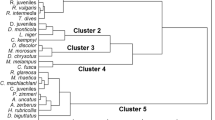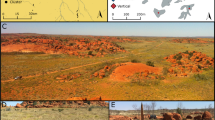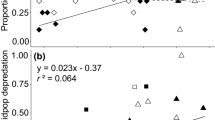Abstract
Patch structure in sandy, compared to rocky streams, is characterized by isolated snags that can only be colonized by drifting. By measuring drift from patches (snags) of various quality we determined the factors that influence habitat selection and drift of the predaceous stoneflies Acroneuria abnormis and Paragnetina fumosa. The presence of refugia (loose bark and leaf packs) was more important than hunger level and modified the effects of increased predator densities and aggressive interactions. Stoneflies concentrated to 8x natural densities with access to refugia remained longer on snags than a single stonefly without access to refugia. During periods of activity, refugia were defended with larger stoneflies always displacing smaller nymphs. During long periods of inactivity, two and sometimes three nymphs would rest side-by-side sharing the same refuge. Hunger level (starved versus satiated stoneflies), an indirect measure of a predator's response to prey availability, had no significant effect on drift or habitat selection regardless of the presence of refugia. Stonefly predators had a uniform distribution while their prey were clumped. Drift was deliberate and almost always delayed until night, usually at dusk or dawn. An examination of previous research plus the results of this study suggest that non-predatory intra- and interspecific interactions can be an important mechanism causing drift in streams.
Similar content being viewed by others
References
Allan JD (1978) Trout predation and the size composition of stream drift. Limnol Oceanogr 23:1231–1237
Allan JD (1982) The effects of reduction of trout density on the invertebrate community of a mountain stream. Ecology 63:1444–1455
Allan JD (1984) The size composition of invertebrate drift in a Rocky Mountain stream. Oikos 42:68–76
Brigham AR, Brigham WU, Gnilka A (eds) (1982) Aquatic insects and oligochaetes of North and South Carolina. Midwest Aquatic Enterprises, Mahomet, Illinois
Brusven MA, Rose ST (1981) Influence of substrate composition and suspended sediment on insect predation by the torrent sculpin, Cottus rhotheus. Can J Fish Aquat Sci 38:1444–1448
Clements FE (1916) Plant succession: an analysis of the development of vegetation (Publication 424). Carnegie Institute, Washington, D.C.
Connell JH (1978) Diversity in tropical rainforests and coral reefs. Science 199:1302–1310
Corkum LD, Clifford HF (1980) The importance of species associations and substrate types to behavioural drift. Can J Fish Aquat Sci 41:331–341
Cowie RJ, Krebs JR (1979) Optimal foraging in patchy environments. In: Anderson RM, Turner RD, Taylor LR (eds) Population dynamics. Blackwell, Oxford, pp 183–205
Culp JM, Glozier NE, Scrimgeour GJ (1991) Reduction of predation risk under the cover of darkness: avoidence responses of mayfly larvae to a benthic fish. Oecologia 86:163–169
Dunn, OJ (1964) Multiple comparisons using rank sums. Technometrics 6:241–252
Feltmate BW, Williams DD (1991) Path and spatial learning in a stonefly nymph. Oikos 60:64–68
Feltmate BW, Baker RL, Pointing PJ (1986) Distribution of the stonefly nymph Paragnetina media (Plecoptera: Perlidae): influence of prey, predators, current speed and substrate. Can J Fish Aquat Sci 43:1582–1587
Flecker AS (1992) Fish predation and the evolution of invertebrate drift periodicity: evidence from neotropical streams. Ecology 73:438–448
Glass LW, Bovbjerg RV (1969) Density and dispersion of laboratory populations of caddisfly larvae (Cheumatopsyche). Ecology 50:1082–1084
Hart DD (1983) The importance of competitive interactions within stream populations and communities. In: Barnes JR, Minshall GW (eds) Stream ecology. Plenum, New York, pp 99–136
Hart DD (1985) Causes and consequences of territoriality in a grazing stream insect. Ecology 66:404–414
Hart DD (1986) The adaptive significance of territoriality in filter-feeding larval blackflies (Diptera: Simulidae). Oikos 46:88–92
Hildrew AG, Townsend CR (1980) Aggregation, interference and foraging by larvae of Plectrocnemia conspersa (Trichoptera: Polycentropidae). Anim Behav 28:553–560
Kohler SL (1985) Identification of stream drift mechanisms: an experimental and observational approach. Ecology 66:1749–1761
Lancaster J (1990) Predation and drift of lotic macroinvertebrates during colonization. Oecologia 85:48–56
Lancaster J, Hildrew AG, Townsend CR (1991) Invertebrate predation on patchy and mobile prey in streams. J Anim Ecol 60:625–641
Lima SL, Dill LM (1990) Behavioral decisions made under the risk of predation: a review and prospectus. Can J Zool 68:619–640
Ludwig JA, Reynolds JF (1988) Statistical ecology: a primer on methods and computing. Wiley, New York
Malmqvist B, Sjöström P (1988) Stream drift as a consequence of disturbance by invertebrate predators: field and laboratory experiments. Oecologia 74:396–403
McAuliffe JR (1984) Competition for space, disturbance, and the structure of a benthic stream community. Ecology 65:894–908
Meffe GK, Sheldon AL (1988) The influence of habitat structure on fish assemblage composition in southeastern blackwater streams. Am Midl Nat 120:225–240
Michael DI, Culver DA (1987) Influence of plecopteran and megalopteran predators on Hydropsyche (Trichoptera: Hydropsychidae) microdistribution and behavior. J N Am Benthol Soc 6:46–55
Peckarsky BL (1980) Predator-prey interactions between stone-flies and mayflies: behavioral observations. Ecology 61: 932–943
Peckarsky BL (1985) Do predaceous stoneflies and siltation affect the structure of stream insect communities colonizing enclosures? Can J Zool 63:1519–1530
Peckarsky BL (1988a) Is predaceous stonefly behavior affected by competition? Ecology 66:1718–1728
Peckarsky BL (1988b) Why predaceous stoneflies do not aggregate with their prey. Verh Int Verein Limnol 23:2135–2140
Peckarsky BL (1991a) Habitat selection by stream-dwelling predatory stoneflies. Can J Fish Aquat Sci 48:1069–1076
Peckarsky BL (1991b) Mechanisms of intra- and interspecific interference between larval stoneflies. Oecologia 85:521–529
Peckarsky BL, Penton MA (1985) Is predaceous stonefly behavior affected by competition? Ecology 66:1718–1728
Peckarsky BL, Cowan CA (1991) Consequences of laryal intraspecific competition to stonefly growth and fecundity. Oecologia 88:277–288
Pickett STA, White PS (1985) The ecology of natural disturbance and patch dynamics. Academic Press, New York
Rader RB, McArthur JV, Aho JM (1994) The relative importance of mechanisms determining decomposition in a southeastern, blackwater stream. Am Midl Nat 131:19–31
Sih A (1980) Optimal behavior: can foragers balance two conflicting demands? Science 210:1041–1043
Sjöström P (1985) Territoriality in nymphs of Dinocras cephalotes (Plecoptera). Oikos 45:353–357
Sousa WP (1979) Experimental investigation of disturbance and ecological succession in a rocky intertidal algal community. Ecol Monogr 49:227–254
Stewart KW, Stark BP (1988) Nymphs of North American stonefly genera (Plecoptera). Entomological Society of America, Thomas Say Foundation 12, New York, NY, USA
Stewart KW, Szczytko SW (1983) Drift of Ephemeropter and Plecoptera in two Colorado rivers. Freshwater Invert Biol 2:117–131
Townsend CR (1989) The patch dynamics concept of stream community ecology. J N Am Benth Soc 8:36–50
Townsend CR, Hildrew AG (1976) Field experiments on the drifting, colonization and continuous redistribution of stream benthos. J Anim Ecol 45:759–772
Walde SJ, Davies RW (1984) The effect of intraspecific interference on Kogotus nonus (Plecoptera) foraging behavior. Can J Zool 62: 2221–2226
Walton OE (1980) Invertebrate drift from predator-prey associations. Ecology 61:1486–1497
Walton OE, Reice SR, Andrews RW (1977) The effects of density, sediment particle size and velocity on drift of Acroneuria abnormis (Plecoptera). Oikos 28:291–298
Wiley MJ, Kohler SL (1981) An assessment of biological interactions in an epilithic stream community using time-lapse cinematography. Hydrobiologia 78:183–188
Wiley MJ, Kohler SL (1984) Behavioral adaptations of aquatic insects. In: Resh VH, Rosenberg DM (eds) The ecology of aquatic insects. Praeger, New York, pp 101–133
Williams DD (1986) Factors influencing the microdistribution of two sympatric species of Plecoptera: an experimental study. Can J Fish Aquat Sci 43:1005–1009
Williams DD (1987) A laboratory study of predator-prey interactions of stoneflies and mayflies. Freshwater Biol 17:471–490
Author information
Authors and Affiliations
Rights and permissions
About this article
Cite this article
Rader, R.B., McArthur, J.V. The relative importance of refugia in determining the drift and habitat selection of predaceous stoneflies in a sandy-bottomed stream. Oecologia 103, 1–9 (1995). https://doi.org/10.1007/BF00328418
Received:
Accepted:
Issue Date:
DOI: https://doi.org/10.1007/BF00328418




